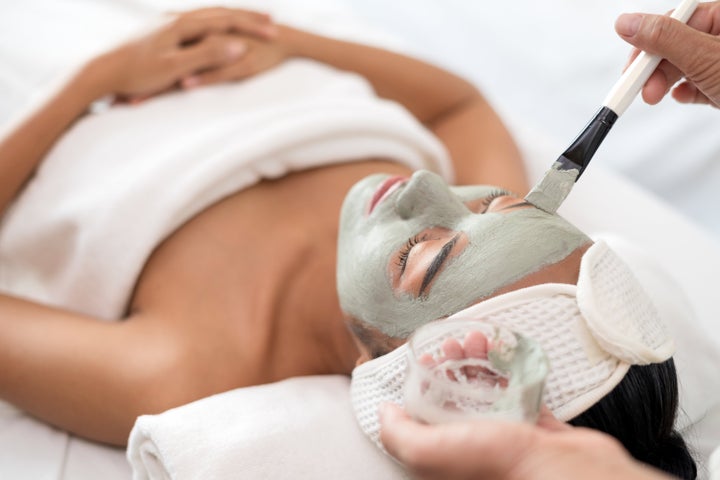
One of the first steps of any facial is the aesthetician getting up close and personal with your skin. As you’re lying down, they’re nearly nose to nose with you, examining your pores and wrinkles while asking about your skin concerns and typical skin care routine.
It can be a little jarring to have someone look so closely at your clean, bare skin when many of us typically try to cover up our acne scars, dark circles, large pores and oily patches.
Oftentimes, aestheticians will provide personal recommendations for which facial you should try and any additional treatments you may need after their assessment. And it makes you wonder: What are these skin care professionals seeing about your skin through their expert eyes?
“When it comes to skin analysing, I am a detective,” said Soyoki Abo, an aesthetician and the founder of Abosoyoki in New York City. “I take time to observe and analyse my clients’ skin every time I see them.”
Our skin says a lot about us, and its needs frequently change. All sorts of things can throw our skin care out of whack. Just about anything can disrupt our skin’s delicate balance, from the environment and our daily habits to the skin care products we use and our body’s hormones.
After talking to the leading aestheticians, it was clear: A close inspection of the faces gives them more information than we could ever realise.
What Your Type Of Acne Says About Your Lifestyle
Blemishes are an unavoidable annoyance in life, and an aesthetician can learn the reason behind frequent breakouts by looking at the appearance of your acne.
“When a client has acne or clusters of blemishes, depending on the location, it can determine a potential cause,” said Kimberly Currie, a licensed advanced aesthetician who owns Oui Glam Studio in Pittsburgh.
“Breakouts on the cheeks could be a result of poor diet or dirty cellphones,” Currie explained. “Additionally, the presence of acne scars may indicate a history of picking or popping pimples.”
For women, hormones can wreak havoc on the skin and cause dreaded breakouts, typically appearing only on certain areas of the face. “Most hormonal breakouts are along the jawline, and they can go down onto the neck,” said Reon’a Richberg, a master aesthetician at SkinSpirit, which is based in Charlotte, North Carolina.
What Your Wrinkles Say About You
Just as a palm reader bases your future on the lines of your hands, an aesthetician can read a lot from the wrinkles on your face.
Each expression you make stretches the skin, and those who tend to make repetitive facial movements develop more wrinkles in those areas.
“Strong frown lines between the brows could indicate that someone is frequently frowning, or that they have a ‘concentration face,’ usually from frowning a lot working on the computer,” said Ginille Brown, a registered aesthetic nurse practitioner and the owner of Ginille Beauty Aesthetics.
She added, “More lines around the eyes, known as crow’s-feet, could indicate that the person smiles a lot or is frequently squinting from being in the sun.”
However, the most shocking revelation from facial wrinkles relates to our sleeping habits. Aestheticians can often deduce these with a quick exam.
“I can tell what side of your face you primarily sleep on due to the symmetry of the client’s face, as well as if they have more fine lines, wrinkles and breakouts on that side,” Richberg said.
Brown noted another characteristic that can suggest you’re a side sleeper: “The cheek that sits lower and is flatter than the other usually indicates that the patient sleeps on that side of the face.”
What They Can Tell From Your Skin Colour And Tone
Redness, hyperpigmentation and irritation can also give away information about you and your skin habits.
“When a client has uneven skin tone or hyperpigmentation it can indicate a client’s sun exposure, hormonal changes or previous skin damage,” Currie said. “Dark spots or patches may indicate sun damage, while melasma (darkening of the skin) may be linked to hormonal fluctuations (like pregnancy).”
“I can tell if you do a lot of driving or are more of a passenger,” said Savannah Frommel, an aesthetician with The Spa at Selenite in Charlotte. “If someone is driving a lot, they’re getting more sun damage, specifically on the left side of the face because that’s the side being exposed to direct sunlight.”
Frommel continued: “This direct sunlight breaks down collagen, resulting in deeper lines and wrinkles on that side of the face. And, of course, sun exposure often results in more sun damage on that side.”
For those with skin redness, the cause may be less clear. According to Abo, “Redness is trickier, as it can be caused by harsh products, medications, dryness, sun damage, rosacea, hormonal issues and allergies.”
If Currie sees redness, irritation or inflammation when looking at a client’s skin, she likes to do a deep dive into their daily skin care products to determine which one may be the culprit.
Next time you go for a facial, test out your aesthetician’s skin-reading skills by asking what concerns they see. They may have revelations that will surprise you.
“It’s important to note that these observations are not definitive diagnoses,” Currie said. “A thorough consultation with an aesthetician is necessary to accurately assess and address specific skin concerns.”